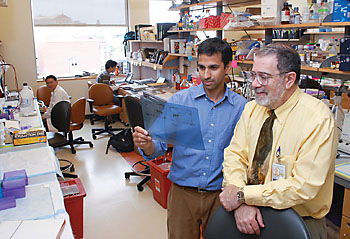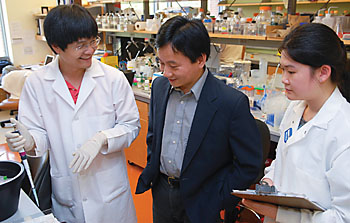 | The work that will be done in the new facility on Amistad Street is "truly a model for 21st-century research," says Medical School Dean Dr. Robert Alpern. |
If, as Yale scientist Jordan Pober says, translational medicine is a team
sport, then the University’s newest science building, at 10 Amistad St. — which
was officially opened on Oct. 5 — might be seen as the Madison Square
Garden of research facilities. —Michael Fitzsousa
T H I S
New facility is place where
‘future of medicine’ can unfold
The facility will serve as home to three programs focusing on translational research,
linking basic studies in animal models to the health of people and potential
cures.
Pober, head of the Human and Translational Immunology Program and vice chair
of immunobiology at the School of Medicine, says the opening of the $88.6 million
building is a milestone for science at the medical school. Not only does it provide
much-needed lab space for several dozen investigators, but it will enable them
to collaborate in ways that will produce results greater than the sum of the
parts.
“This is the future,” said President Richard C. Levin at the ribbon-cutting
ceremony that, along with a scientific symposium, celebrated the building’s
opening. “We look forward to many more investments in science at Yale to
improve man’s understanding of nature and to improve the human condition.”
Provost Andrew Hamilton said the new building “is going to be a place where
great science is done. It has been constructed at the cutting edge of sustainable
and green design.”
“This building,” added Medical School Dean Dr. Robert Alpern, “will
house three outstanding science programs, all focused on what everybody calls
the future of medicine: interdisciplinary science.”
Unlike traditional biomedical research teams — often composed of members
of one discipline working in a single animal model — the three research
programs housed in the 110,000-square-foot building draw from multiple departments
and have shifted their focus solely from rodent studies to better understanding
what works, and doesn’t work, in humans.
“The challenge is not to abandon animal research,” Pober says, “but
to assemble other individuals who can be a bridge between people who study disease
models and clinicians who take care of patients.”
The three groups include faculty members, such as Pober, who have been at Yale
for many years as well as new recruits from other institutions and nations, including
Russia, China and Japan.
“This new building is truly a model for 21st-century research,” said
Alpern, “because it allows scientists with different expertise to attack
problems from many angles.”
The Amistad Street building is part of the University’s $1 billion program
to boost science and medicine. The four-story building and adjoining garage, constructed
earlier at a cost of $24.2 million, opens on the heels of Yale’s acquisition
of the 136-acre Bayer campus in West Haven and Orange, which includes 550,000
square feet of laboratory space.
The programs that will be headquartered in the Amistad Street building are as
follows:

Two floors of the Amistad Street building are devoted to the Interdepartmental Program in Vascular Biology and Therapeutics, led by William Sessa.
The Interdepartmental Program in Vascular Biology and Therapeutics
Vascular biology is the study of the cells and molecules that interact in the
vascular system, which supplies the organs and every cell in the body with oxygen
and nutrients. According to William Sessa, the program’s director and professor
of pharmacology, the group’s research is clinically relevant to cardiac
disease. Its researchers will be studying the mechanisms underlying the blockage
of arteries, as well as therapeutic angiogenesis, which involves stimulating
the growth of collateral blood vessels on the heart, as well creating synthetic
blood vessels.
Twelve investigators in the program are housed in two floors of labs. More than
40 Yale faculty members are affiliated with the program, including researchers
from internal medicine, surgery, anesthesiology, pharmacology, pathology and
immunobiology.

Jordan Pober (right) is director of the Human and Translational Immunology Program, which will focus on diseases related to organ transplantation, autoimmune disorders and the application of Immunotherapies to infectious disease, among other issues.
Human and Translational Immunology Program
Pober and Kevan Herold, professor of immunology, are the first two of what will
eventually be eight core members in this program (one senior and five junior
faculty members are still to be recruited). Pober says some of the diseases the
group will be targeting relate to organ transplantation. They will also be studying
the application of immunotherapies to infectious disease or cancer, and the basis
for autoimmune disorders, such as asthma, type 1 diabetes and
lupus. In addition, the group will look at other diseases, such as arteriosclerosis,
which lend themselves to therapeutic interventions by means of the immune system.
Herold, who has a secondary appointment in internal medicine/endocrinology, is
in the midst of clinical trials in which the immune system is manipulated to
obtain a remission or reversal of type 1 diabetes. Pober is working on ways to
reduce the death rate in patients who receive organ transplants.
“Transplantation is an effective treatment for end organ failure. Most
patients who undergo kidney transplantation and die do so because of heart failure,
not because of rejection of the kidney,” he said. “We want to know
why and how to prevent it.”

The "tremendous potential" of stem cells for curing many medical conditions will be explored at the Yale Stem Cell Center, led by Haifan Lin (center).
Yale Stem Cell Center
Led by Haifan Lin, professor of cell biology, this group is studying stem cell
behavior.
“The stem cell,” Lin says, “is the mother of all cells. It
harbors tremendous potential for curing cancer, Parkinson’s disease, Alzheimer’s
and spinal cord injury.”
With his associate director, Diane Krause, professor of laboratory medicine and
pathology, Lin is recruiting four more faculty members to conduct basic stem
cell research and to investigate applications. They recently recruited Natalia
Ivanova, formerly of Princeton University. “She has made landmark contributions
to the stem cell field,” Lin says. “She has a very deep understanding
of stem cell biology as well as cutting-edge technology, which is an unusual
combination.”
The ways in which stem cells can both renew and develop into many different cell
types is only partly understood. Lin is optimistic that these mechanisms will
be decoded and one day lead to medical treatments.
“Just imagine,” he says, “if we were able to grow tissues to
replace damaged heart muscle or brain tissues.”
Lin’s discovery of piRNAs, a complex dimension of the genetic circuitry,
was voted by Science magazine as one of the top 10 breakthroughs of 2006. His
lab’s latest work suggests that piRNAs, which are mostly derived from so-called “junk
DNA,” have crucial functions in controlling the stem cell fate and other
processes of tissue development.
Yale has been one of the top beneficiaries of the State of Connecticut’s
allocation of funds to stem cell research, which will total $100 million statewide
over a 10-year period. The state legislature also created a safe haven in Connecticut
for work on human embryonic stem (hES) cell research, which is ineligible for
federal funding except for certain cell lines established before President Bush’s
executive order of Aug. 9, 2001. The stem cell center contains a core facility
for culturing hES cells, enabling hES research to be conducted.
Director of Communications
Yale School of Medicine  W E E K ' S
W E E K ' S S T O R I E S
S T O R I E S![]()
 New facility is place where ‘future of medicine’ can unfold
New facility is place where ‘future of medicine’ can unfold![]()
![]()
 Facility balances researchers’ needs with environmentally friendly features
Facility balances researchers’ needs with environmentally friendly features![]()
![]()
 Alumnus’ gift supports ‘critical’ work at F&ES
Alumnus’ gift supports ‘critical’ work at F&ES![]()
![]()
 Yale affiliates to exhibit photographs, games and paintings at art festival
Yale affiliates to exhibit photographs, games and paintings at art festival![]()
![]()
 Yale’s United Way fundraising goal set at $1.2 million
Yale’s United Way fundraising goal set at $1.2 million![]()
![]()
 SCHOOL OF MEDICINE NEWS
SCHOOL OF MEDICINE NEWS
 Yale to take part in national study examining children’s health
Yale to take part in national study examining children’s health![]()
 Three members of faculty elected to Institute of Medicine
Three members of faculty elected to Institute of Medicine![]()
 Dr. David Fiellin receives NIH grant . . .
Dr. David Fiellin receives NIH grant . . .![]()
 Chronic Lyme disease does not exist, researchers report
Chronic Lyme disease does not exist, researchers report![]()
 Spouses follow suit in health behaviors, study reveals
Spouses follow suit in health behaviors, study reveals![]()
![]()
 Museum honorees to ponder ‘The Future of Life on Earth’
Museum honorees to ponder ‘The Future of Life on Earth’![]()
![]()
 ‘The Greening of Yale and Beyond’ is topic of symposium
‘The Greening of Yale and Beyond’ is topic of symposium![]()
![]()
 Symposium to examine the intersection of faith and politics
Symposium to examine the intersection of faith and politics![]()
![]()
 ‘21st Century Democracy’ is the theme of Law School reunions
‘21st Century Democracy’ is the theme of Law School reunions![]()
![]()
 IN MEMORIAM
IN MEMORIAM
 Deno Geanakoplos: One of world’s foremost Byzantine scholars
Deno Geanakoplos: One of world’s foremost Byzantine scholars![]()
 Felix Zweig: Former dean’s impact still felt in Yale engineering today
Felix Zweig: Former dean’s impact still felt in Yale engineering today![]()
![]()
 Exhibit examines post-war effort to halt the spread of communism . . .
Exhibit examines post-war effort to halt the spread of communism . . .![]()
![]()
 Campus Notes
Campus Notes![]()
Bulletin Home |
| Visiting on Campus
Visiting on Campus |
| Calendar of Events
Calendar of Events |
| In the News
In the News![]()
Bulletin Board |
| Classified Ads
Classified Ads |
| Search Archives
Search Archives |
| Deadlines
Deadlines![]()
Bulletin Staff |
| Public Affairs
Public Affairs |
| News Releases
News Releases |
| E-Mail Us
E-Mail Us |
| Yale Home
Yale Home